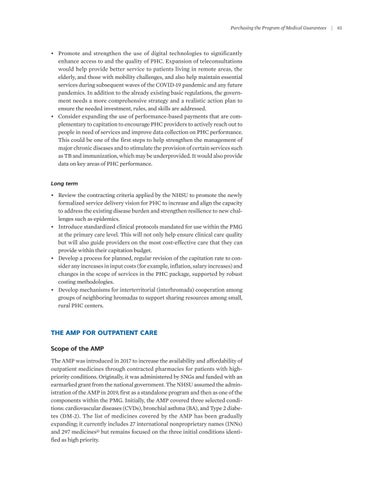Purchasing the Program of Medical Guarantees
• Promote and strengthen the use of digital technologies to significantly enhance access to and the quality of PHC. Expansion of teleconsultations would help provide better service to patients living in remote areas, the elderly, and those with mobility challenges, and also help maintain essential services during subsequent waves of the COVID-19 pandemic and any future pandemics. In addition to the already existing basic regulations, the government needs a more comprehensive strategy and a realistic action plan to ensure the needed investment, rules, and skills are addressed. • Consider expanding the use of performance-based payments that are complementary to capitation to encourage PHC providers to actively reach out to people in need of services and improve data collection on PHC performance. This could be one of the first steps to help strengthen the management of major chronic diseases and to stimulate the provision of certain services such as TB and immunization, which may be underprovided. It would also provide data on key areas of PHC performance. Long term
• Review the contracting criteria applied by the NHSU to promote the newly formalized service delivery vision for PHC to increase and align the capacity to address the existing disease burden and strengthen resilience to new challenges such as epidemics. • Introduce standardized clinical protocols mandated for use within the PMG at the primary care level. This will not only help ensure clinical care quality but will also guide providers on the most cost-effective care that they can provide within their capitation budget. • Develop a process for planned, regular revision of the capitation rate to consider any increases in input costs (for example, inflation, salary increases) and changes in the scope of services in the PHC package, supported by robust costing methodologies. • Develop mechanisms for interterritorial (interhromada) cooperation among groups of neighboring hromadas to support sharing resources among small, rural PHC centers.
THE AMP FOR OUTPATIENT CARE Scope of the AMP The AMP was introduced in 2017 to increase the availability and affordability of outpatient medicines through contracted pharmacies for patients with high- priority conditions. Originally, it was administered by SNGs and funded with an earmarked grant from the national government. The NHSU assumed the administration of the AMP in 2019, first as a standalone program and then as one of the components within the PMG. Initially, the AMP covered three selected conditions: cardiovascular diseases (CVDs), bronchial asthma (BA), and Type 2 diabetes (DM-2). The list of medicines covered by the AMP has been gradually expanding; it currently includes 27 international nonproprietary names (INNs) and 297 medicines13 but remains focused on the three initial conditions identified as high priority.
|
61

